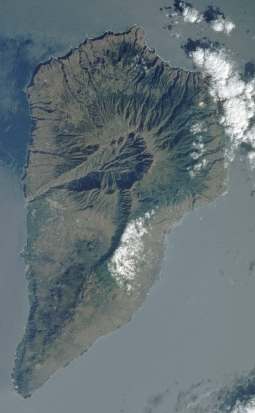Those worried that a holiday in the Canary Islands might be interrupted by a devastating collapse of the volcanic island of La Palma and an ensuing tsunami can relax. According to researchers in the Netherlands, La Palma is a lot more stable than is generally assumed, and holidays can go ahead as planned, at least for the next 10000 years, they say.
Jan Nieuwenhuis and his colleagues have cast doubts on pessimistic estimates of the effects of a collapse of the southwestern flank of La Palma caused by a volcanic eruption. Geologists had previously calculated that such a collapse would cause a mega tsunami that might roar across the Atlantic wreaking havoc on the US eastern seaboard, Europe, and Africa, with waves initially 650 metres high moving at 800 kilometres per hour. A tsunami on this scale could wipe New York, Boston, Lisbon, and Casablanca from the face of the map.

Robert Jan Labeur
However, according to the new research, the volcano Cumbre Vieja is simply too small to fall apart…yet. So, a mega tsunami should not happen any time soon. Nieuwenhuis and his colleagues, Robert Jan Labeur and Ronald Brinkgreve, modelled the inside of the flank and then simulated several volcanic eruptions and steam explosions. Cumbre Vieja remained intact in every simulation. This is simply a very stable island’, explains Nieuwenhuis in the journal Delft Integraal.
According to his calculations, a force of at least 12 million million Newtons would be necessary to tear the island apart. That would be the equivalent of the combined strength of 600 million fighter jet engines. A volcanic outburst on La Palma would exert far less force than this, the team says. Nieuwenhuis cautions that under incredibly extreme conditions, however, the flank could become unstable. An exceptionally powerful outburst of magma coinciding with usually heavy rainfall or some other unlikely combination of circumstances would be needed. Based on what we know now, so many things must go wrong that a disaster seems very, very unlikely’, adds colleague Janneke van Berlo.

The Space Shuttle’s view of La Palma (Credit: NASA)
However, as the years pass, so the Cumbre Vieja will grow and its sides become steeper. 10,000 years from now, its flanks may be rendered unstable. A combination of substantial vertical growth and eruption forces will most probably act to trigger failure, van Berlo says.
But, Nieuwenhuis’s calculation does not appear in accord with the present state of La Palma, which doesn’t look very solid even today. It has lost chunks of its flanks at least twice in prehistoric time and during the last eruption, in 1949, a two kilometre rip appeared at the top of Cumbre Vieja’s southwestern flank. The Delft researchers explain that the rip was caused by innocent, shallow phenomenon that won’t lead to tsunami-producing conditions. That said, this work is, like that of the originators of the original risk assessment, the Benfield Greig Hazard Research Centre, theoretical. If I were holidaying in the Canaries, I’d keep one eye on your book and the other on that rip, just in case.
Further reading
More about mega-tsunamis
http://www.benfieldhrc.org/tsunamis/mega_tsunami_more.htm
Suggested searches
tsunamis
volcanoes<